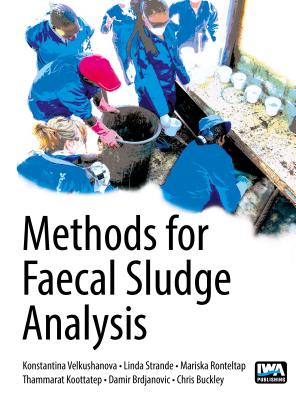The importance and need for faecal sludge management has been recognised worldwide. One major gap in developing appropriate and adequate faecal sludge treatment and monitoring techniques is the ability to understand faecal sludge characteristics, its quantification and correlation to source populations. Faecal sludge characteristics are highly variable, but as standard methods for sampling and analysis do not exist, results are not comparable and hence the actual variability is not yet fully understood.Due to the lack of standard methods for sampling and analysis of faecal sludge, standard methods from other fields such as water, wastewater and soil science are usually applied. However, these methods are not necessarily the most suitable for faecal sludge, and have not been specifically adapted for that purpose. Characteristics of faecal sludge are typically different from these other matrices by orders of magnitude. The methods for faecal sludge sampling are also greatly complicated by the wide range of technologies in each local context, and the heterogeneity within systems. Another gap in existing knowledge is how to quantify faecal sludge on a city-wide scale, or scale relevant for the design of treatment technologies. Moreover, the lack of standardisation complicates the transfer of knowledge and data between different regions and institutions as the results are not comparable. This illustrates the urgent need to establish common methods and procedures for faecal sludge characterisation and quantification.This book aims to address these challenges and provide a basis towards standardized methods for characterisation and quantification of faecal sludge from onsite sanitation technologies, including sampling techniques and health and safety procedures for faecal sludge handling. It also aims at improved communication between sanitation practitioners, comparative faecal sludge database and improved confidence in the methods and obtained results. The book will be beneficial for researchers, laboratory technicians, academics, students and sanitation practitioners.
Faecal sludge management is recognized globally as an essential component of city-wide inclusive sanitation. However, a major gap in developing appropriate and adequate management and monitoring for faecal sludge is the ability to understand and predict thecharacteristics and volumes of accumulated faecal sludge, and correlations to source populations. Since standard methods for sampling and analysing faecal sludge do not currently exist, results are not comparable, the actual variability is not yet fully understood, and the transfer of knowledge and data between different regions and institutions can be challenging and often arbitrary. Due to this lack of standard analytical methods for faecal sludge, methods from other fields, such as wastewater management, and soil and food science are frequently applied. However, these methods are not necessarily the most suitable for faecal sludge analysis, and have not been specifically adapted for this purpose. Characteristics of faecal sludge can be different than these other matrices by orders of magnitude. There is also a lack of standard methods for sampling, which is complicated by the difficult nature of in situ sampling, the wide range of onsite sanitation technologies and potential sampling locations, and the diverse heterogeneity of faecal sludge within onsite containments and within cities. This illustrates the urgent need to establish common methods and procedures for faecal sludge characterisation, quantification, sampling, and modelling. The aim of this book is to provide a basis for standardised methods for the analysis of faecal sludge from onsite sanitation technologies, for improved communication between sanitation practitioners, and for greater confidence in the generated data. The book presents background information on types of faecal sludge, methods for sample collection, health and safety procedures for handling, case studies of experimental design, an approach for estimating faecal sludge at community to city-wide scales, modelling containment and treatment processes, recipes for simulants, and laboratory methods for faecal sludge analysis currently in use by faecal sludge laboratories. This book will be beneficial for researchers, laboratory technicians, academics, students and sanitation practitioners.
Get Methods for Faecal Sludge Analysis by at the best price and quality guranteed only at Werezi Africa largest book ecommerce store. The book was published by IWA Publishing and it has pages. Enjoy Shopping Best Offers & Deals on books Online from Werezi - Receive at your doorstep - Fast Delivery - Secure mode of Payment
 Jacket, Women
Jacket, Women
 Woolend Jacket
Woolend Jacket
 Western denim
Western denim
 Mini Dresss
Mini Dresss
 Jacket, Women
Jacket, Women
 Woolend Jacket
Woolend Jacket
 Western denim
Western denim
 Mini Dresss
Mini Dresss
 Jacket, Women
Jacket, Women
 Woolend Jacket
Woolend Jacket
 Western denim
Western denim
 Mini Dresss
Mini Dresss
 Jacket, Women
Jacket, Women
 Woolend Jacket
Woolend Jacket
 Western denim
Western denim
 Mini Dresss
Mini Dresss
 Jacket, Women
Jacket, Women
 Woolend Jacket
Woolend Jacket
 Western denim
Western denim
 Mini Dresss
Mini Dresss






























































